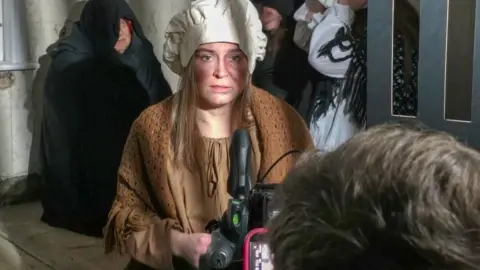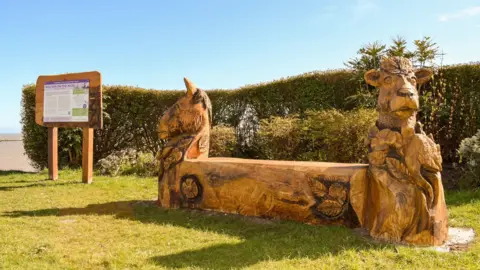Witch trials 'brought to life' by interactive tour
 Tendring District Council
Tendring District CouncilA visitor trail about witch trials in the 16th and 17th centuries is being brought to life by augmented reality.
The Tendring Witch Heritage Trail is set in Harwich, Manningtree, St Osyth and Walton-on-the-Naze in Essex.
Visitors can use an app to watch re-enactments and animations about particular individuals from the area.
Organisers said the trail would offer a fascinating insight into the trials, which saw 74 people executed for witchcraft in the county between 1560 and 1680.
The heritage trail locations include a site off Woodberry Way in Walton-on-the-Naze and at the junction of Kiln Lane and The Walls in Manningtree.
Each features a unique carved wooden bench that reflects the local history, along with an information board about the trials
The project was organised by Tendring District Council and received nearly £50,000 of funding from the Rural England Prosperity Fund.
 Tendring District Council
Tendring District CouncilGary Scott, the council's cabinet member for arts, culture and heritage, said he was "thrilled" with the immersive project.
"It not only preserves our past, but it brings to life the rich stories that have shaped our history," he said.
"The trail also commemorates the lives of the Tendring communities that were brutally persecuted for witchcraft in the 16th and 17th Centuries."
Professor of European history Alison Rowlands from the University of Essex advised on the trail.
She said: "I'm thrilled to see the finished results in their local settings and hope many other people from our region will be inspired to visit them."
What were the witch trials?
The witch trials came to a head in the 16th and 17th centuries, with about 500 people executed for witchcraft in England, with Essex a key site for prosecutions.
Witch trials often relied on accusations by local people, with cases fuelled by fear, superstition and social tensions.
Witchcraft was criminalised in England by Acts of Parliament issued in 1542, 1563 and 1604.
Records show that of 291 accused of witchcraft in Essex between 1560 and 1680, 74 were hanged, 55 were imprisoned and 36 died behind bars.
Follow Essex news on BBC Sounds, Facebook, Instagram and X.
